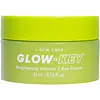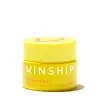What's inside
What's inside
 Key Ingredients
Key Ingredients

 Benefits
Benefits

 Concerns
Concerns

 Ingredients Side-by-side
Ingredients Side-by-side

Water
Skin ConditioningGlycerin
HumectantDiisostearyl Malate
EmollientHydrogenated Poly(C6-14 Olefin)
Emollient1,2-Hexanediol
Skin ConditioningEthylhexyl Palmitate
EmollientLimnanthes Alba Seed Oil
Skin ConditioningNiacinamide
SmoothingPentaerythrityl Tetraethylhexanoate
EmollientPolymethylsilsesquioxane
Myristyl Myristate
EmollientPEG-150 Distearate
EmulsifyingPolyglyceryl-3 Methylglucose Distearate
EmulsifyingCetearyl Alcohol
EmollientCI 77891
Cosmetic ColorantHydrogenated Olive Oil Lauryl Esters
Emulsion StabilisingPentylene Glycol
Skin ConditioningSqualane
EmollientEuphrasia Officinalis Extract
AntimicrobialHydrolyzed Hyaluronic Acid
HumectantAscorbic Acid
AntioxidantPalmitoyl Tripeptide-5
Skin ConditioningCamellia Sinensis Leaf Extract
AntimicrobialLuffa Cylindrica Fruit Extract
Skin ConditioningPsidium Guajava Fruit Extract
AstringentPsidium Guajava Leaf Extract
AstringentTocopherol
AntioxidantCyanocobalamin
Skin ConditioningCoffea Arabica Seed Extract
MaskingHydrogenated Lecithin
EmulsifyingGlyceryl Stearate
EmollientMica
Cosmetic ColorantHydroxyethyl Acrylate/Sodium Acryloyldimethyl Taurate Copolymer
Emulsion StabilisingCopernicia Cerifera Wax
Theobroma Grandiflorum Seed Butter
Skin ConditioningCaprylic/Capric Triglyceride
MaskingCaprylyl Glycol
EmollientBehenic Acid
CleansingSilica
AbrasiveSynthetic Fluorphlogopite
Stearic Acid
CleansingBehenyl Alcohol
EmollientStearyl Alcohol
EmollientHydrogenated Olive Oil Unsaponifiables
EmollientXanthan Gum
EmulsifyingParfum
MaskingEthylhexylglycerin
Skin ConditioningAdenosine
Skin ConditioningPolyglyceryl-10 Stearate
Skin ConditioningMyristic Acid
CleansingDisodium EDTA
Phenoxyethanol
PreservativeMelia Azadirachta Flower Extract
Skin ConditioningMelia Azadirachta Leaf Extract
Skin ConditioningCurcuma Longa Root Extract
MaskingOcimum Sanctum Leaf Extract
Skin ConditioningButylene Glycol
HumectantCorallina Officinalis Extract
Skin ConditioningAllium Sativum Bulb Extract
Skin ConditioningWater, Glycerin, Diisostearyl Malate, Hydrogenated Poly(C6-14 Olefin), 1,2-Hexanediol, Ethylhexyl Palmitate, Limnanthes Alba Seed Oil, Niacinamide, Pentaerythrityl Tetraethylhexanoate, Polymethylsilsesquioxane, Myristyl Myristate, PEG-150 Distearate, Polyglyceryl-3 Methylglucose Distearate, Cetearyl Alcohol, CI 77891, Hydrogenated Olive Oil Lauryl Esters, Pentylene Glycol, Squalane, Euphrasia Officinalis Extract, Hydrolyzed Hyaluronic Acid, Ascorbic Acid, Palmitoyl Tripeptide-5, Camellia Sinensis Leaf Extract, Luffa Cylindrica Fruit Extract, Psidium Guajava Fruit Extract, Psidium Guajava Leaf Extract, Tocopherol, Cyanocobalamin, Coffea Arabica Seed Extract, Hydrogenated Lecithin, Glyceryl Stearate, Mica, Hydroxyethyl Acrylate/Sodium Acryloyldimethyl Taurate Copolymer, Copernicia Cerifera Wax, Theobroma Grandiflorum Seed Butter, Caprylic/Capric Triglyceride, Caprylyl Glycol, Behenic Acid, Silica, Synthetic Fluorphlogopite, Stearic Acid, Behenyl Alcohol, Stearyl Alcohol, Hydrogenated Olive Oil Unsaponifiables, Xanthan Gum, Parfum, Ethylhexylglycerin, Adenosine, Polyglyceryl-10 Stearate, Myristic Acid, Disodium EDTA, Phenoxyethanol, Melia Azadirachta Flower Extract, Melia Azadirachta Leaf Extract, Curcuma Longa Root Extract, Ocimum Sanctum Leaf Extract, Butylene Glycol, Corallina Officinalis Extract, Allium Sativum Bulb Extract
Water
Skin ConditioningCetyl Alcohol
EmollientGlycerin
HumectantPotassium Cetyl Phosphate
EmulsifyingAvena Sativa Kernel Oil
Skin ConditioningSimmondsia Chinensis Seed Oil
EmollientAstrocaryum Tucuma Seed Butter
EmollientC12-15 Alkyl Benzoate
AntimicrobialCapryloyl Glycerin/Sebacic Acid Copolymer
Skin ConditioningDiheptyl Succinate
EmollientTetrahexyldecyl Ascorbate
AntioxidantSqualene
EmollientHippophae Rhamnoides Oil
EmollientJania Rubens Extract
Skin ConditioningLactobacillus Ferment
Skin ConditioningInonotus Obliquus Extract
Skin ConditioningMoringa Oleifera Seed Oil
EmollientArachidyl Alcohol
EmollientBehenyl Alcohol
EmollientArachidyl Glucoside
EmulsifyingJojoba Oil/Macadamia Seed Oil Esters
Skin ConditioningPhytosteryl Macadamiate
Skin ConditioningPhytosterols
Skin ConditioningTocopherol
AntioxidantBenzyl Alcohol
PerfumingSodium Carrageenan
Emulsion StabilisingBentonite
AbsorbentOlive Oil Decyl Esters
Hydrated Silica
AbrasiveCitric Acid
BufferingLactic Acid
BufferingChlorella Vulgaris Extract
Skin ConditioningSea Salt
AbrasiveEclipta Prostrata Extract
Skin ConditioningMelia Azadirachta Leaf Extract
Skin ConditioningSodium Phytate
Dehydroacetic Acid
PreservativePotassium Sorbate
PreservativePhenoxyethanol
PreservativeEthylhexylglycerin
Skin ConditioningWater, Cetyl Alcohol, Glycerin, Potassium Cetyl Phosphate, Avena Sativa Kernel Oil, Simmondsia Chinensis Seed Oil, Astrocaryum Tucuma Seed Butter, C12-15 Alkyl Benzoate, Capryloyl Glycerin/Sebacic Acid Copolymer, Diheptyl Succinate, Tetrahexyldecyl Ascorbate, Squalene, Hippophae Rhamnoides Oil, Jania Rubens Extract, Lactobacillus Ferment, Inonotus Obliquus Extract, Moringa Oleifera Seed Oil, Arachidyl Alcohol, Behenyl Alcohol, Arachidyl Glucoside, Jojoba Oil/Macadamia Seed Oil Esters, Phytosteryl Macadamiate, Phytosterols, Tocopherol, Benzyl Alcohol, Sodium Carrageenan, Bentonite, Olive Oil Decyl Esters, Hydrated Silica, Citric Acid, Lactic Acid, Chlorella Vulgaris Extract, Sea Salt, Eclipta Prostrata Extract, Melia Azadirachta Leaf Extract, Sodium Phytate, Dehydroacetic Acid, Potassium Sorbate, Phenoxyethanol, Ethylhexylglycerin
Alternatives
Ingredients Explained
These ingredients are found in both products.
Ingredients higher up in an ingredient list are typically present in a larger amount.
Behenyl Alcohol is a type of fatty alcohol (these are different from the drying, solvent alcohols).
Fatty Alcohols have hydrating properties and are most often used as an emollient or to thicken a product. They are usually derived from natural fats and oils; behenyl alcohol is derived from the fats of vegetable oils.
Emollients help keep your skin soft and hydrated by creating a film that traps moisture in.
In 2000, Behenyl Alcohol was approved by the US as medicine to reduce the duration of cold sores.
Learn more about Behenyl AlcoholEthylhexylglycerin (we can't pronounce this either) is commonly used as a preservative and skin softener. It is derived from glyceryl.
You might see Ethylhexylglycerin often paired with other preservatives such as phenoxyethanol. Ethylhexylglycerin has been found to increase the effectiveness of these other preservatives.
Glycerin is already naturally found in your skin. It helps moisturize and protect your skin.
A study from 2016 found glycerin to be more effective as a humectant than AHAs and hyaluronic acid.
As a humectant, it helps the skin stay hydrated by pulling moisture to your skin. The low molecular weight of glycerin allows it to pull moisture into the deeper layers of your skin.
Hydrated skin improves your skin barrier; Your skin barrier helps protect against irritants and bacteria.
Glycerin has also been found to have antimicrobial and antiviral properties. Due to these properties, glycerin is often used in wound and burn treatments.
In cosmetics, glycerin is usually derived from plants such as soybean or palm. However, it can also be sourced from animals, such as tallow or animal fat.
This ingredient is organic, colorless, odorless, and non-toxic.
Glycerin is the name for this ingredient in American English. British English uses Glycerol/Glycerine.
Learn more about GlycerinMelia Azadirachta Leaf Extract is extract from the neem plant.
The leaves of this tree contain flavonoids and polyphenols. These two compounds are antioxidants, anti-inflammatory, and antibacterial. Further research is needed as to their effects when applied on skin.
Phenoxyethanol is a preservative that has germicide, antimicrobial, and aromatic properties. Studies show that phenoxyethanol can prevent microbial growth. By itself, it has a scent that is similar to that of a rose.
It's often used in formulations along with Caprylyl Glycol to preserve the shelf life of products.
Tocopherol (also known as Vitamin E) is a common antioxidant used to help protect the skin from free-radicals and strengthen the skin barrier. It's also fat soluble - this means our skin is great at absorbing it.
Vitamin E also helps keep your natural skin lipids healthy. Your lipid skin barrier naturally consists of lipids, ceramides, and fatty acids. Vitamin E offers extra protection for your skin’s lipid barrier, keeping your skin healthy and nourished.
Another benefit is a bit of UV protection. Vitamin E helps reduce the damage caused by UVB rays. (It should not replace your sunscreen). Combining it with Vitamin C can decrease sunburned cells and hyperpigmentation after UV exposure.
You might have noticed Vitamin E + C often paired together. This is because it is great at stabilizing Vitamin C. Using the two together helps increase the effectiveness of both ingredients.
There are often claims that Vitamin E can reduce/prevent scarring, but these claims haven't been confirmed by scientific research.
Learn more about TocopherolWater. It's the most common cosmetic ingredient of all. You'll usually see it at the top of ingredient lists, meaning that it makes up the largest part of the product.
So why is it so popular? Water most often acts as a solvent - this means that it helps dissolve other ingredients into the formulation.
You'll also recognize water as that liquid we all need to stay alive. If you see this, drink a glass of water. Stay hydrated!
Learn more about Water